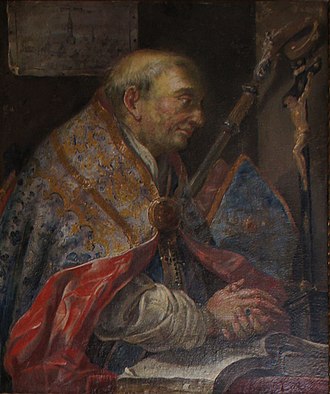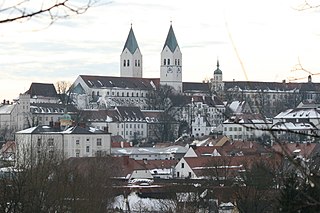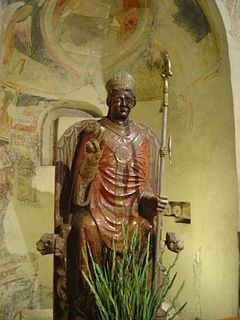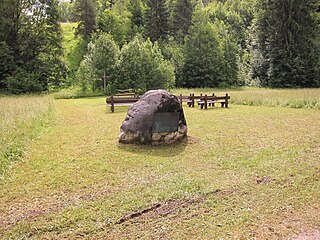
Joseph of Freising (died 17 January 764), also known as Joseph of Verona, was Bishop of Freising from 747 or 748 until his death.

Joseph of Freising (died 17 January 764), also known as Joseph of Verona, was Bishop of Freising from 747 or 748 until his death.
There is no direct evidence of Joseph's place of origin, or place of birth. It is sometimes claimed that he was a native of Verona in Italy, whence his alternative name, but it is equally possible that he was from Bavaria or northern Austria, or perhaps the Tyrol.
He is presumed to have been a monk in Saint Corbinian's new foundation, Freising Abbey, before in 747 or 748 he was appointed bishop of Freising, the third to hold the office. He had the reputation of a zealous and energetic promoter of the interests of the church, to have had a keen grasp of the importance for the church of acquiring large possessions, and to have been highly effective in attracting donations, especially of land.
He was also active as a founder of churches and religious houses. In particular he founded Isen Abbey in 752, and dedicated it to Saint Zeno of Verona. He was also closely involved, after 760, with the respective lay founders in the establishment of Schäftlarn and Scharnitz Abbeys. At Schäftlarn the founders gave him the power of supervision of the monastery and the right to appoint the abbots: his first appointment was Aribo, Joseph's successor as bishop. At Scharnitz he appointed Atto, Aribo's successor as bishop of Freising, also to be highly successful in the acquisition of estates for the diocese.
After his death on 17 January 764, Joseph was buried in the church of Isen Abbey, founded by himself, where his tomb was restored in 1743. The church survived the secularisation of Bavaria in 1802-03 and is still in service as St. Zeno's, the parish church of Isen.
Joseph is venerated locally as the Blessed Joseph, although he was never formally beatified. His feastday is 17 January.

Conrad II, also known as Conrad the Elder and Conrad the Salic, was Emperor of the Holy Roman Empire from 1027 until his death in 1039. The first of a succession of four Salian emperors, who reigned for one century until 1125, Conrad also served as King of Germany from 1024, King of Italy from 1026, and King of Burgundy (Arelat) from 1033.

Freising is a town in Bavaria, Germany, and the capital of the Freising Landkreis (district), with a population of about 50,000.

The Diocese of Passau is a Roman Catholic diocese in Germany that is a suffragan of the Archdiocese of Munich and Freising. Though similar in name to the Prince-Bishopric of Passau—an ecclesiastical principality that existed for centuries until it was secularized in 1803—the two are entirely different entities. The diocese covers an area of 5,442 km².

Saint Gotthard, also known as Gothard or Godehard the Bishop, was a German bishop venerated as a saint.

Saint Corbinian was a Frankish bishop. After living as a hermit near Chartres for fourteen years, he made a pilgrimage to Rome. Pope Gregory II sent him to Bavaria. His opposition to the marriage of Duke Grimoald to his brother's widow, Biltrudis, caused Corbinian to go into exile for a time. His feast day is 8 September. The commemoration of the translation of his relics is 20 November.

Zeno of Verona was either an early Christian Bishop of Verona or a martyr. He is a saint in the Roman Catholic Church and in the Eastern Orthodox Church.
Odilo, also Oatilo or Uatilo of the Agilolfing dynasty was Duke of Bavaria from 736 until his death. He had the Lex Baiuvariorum compilation edited, the first ancient Germanic law collection of the Bavarians.

Tegernsee Abbey is a former Benedictine monastery in the town and district of Tegernsee in Bavaria. Both the abbey and the town that grew up around it, are named after the Tegernsee, the lake on the shores of which they are located. The name is from the Old High German tegarin seo, meaning great lake.

January 16 - Eastern Orthodox liturgical calendar - January 18

Arbeoof Freising was an early medieval author and Bishop of Freising from 764.

Scharnitz Abbey was a Benedictine monastery in Mittenwald in Bavaria, Germany.

Seeon Abbey was a Benedictine monastery in the municipality of Seeon-Seebruck in the rural district of Traunstein in Bavaria, Germany.

Isen Abbey was a Benedictine abbey, later a collegiate foundation, at Isen in Bavaria, Germany.
Ursberg Abbey is a former Premonstratensian monastery, now a convent of the Franciscan St. Joseph's Congregation, situated in the small village of Ursberg in the district of Günzburg, Bavaria.
The Aribonids were a noble family of probably Bavarian origin who rose to preeminence in the Carolingian March of Pannonia and the later Margraviate of Austria in the late ninth and early tenth centuries. The dynasty is named after its ancestor Margrave Aribo of Austria. The Aribonids maintained influence in the Duchy of Bavaria, the Austrian march, and other parts of Germany until the early twelfth century, when they disappear.
Saint Sturm, also called Sturmius or Sturmi, was a disciple of Saint Boniface and founder and first abbot of the Benedictine monastery and abbey of Fulda in 742 or 744. Sturm's tenure as abbot lasted from 747 until 779.

The Prince-Bishopric of Freising was an ecclesiastical principality of the Holy Roman Empire from 1294 until its secularisation in the early years of the 19th century.

Hitto of Freising was the sixth Bishop of Freising from December 811 to 835.

Leidrad was the bishop of Lyon from 797 and its first archbishop from 804 until 814. He was a courtier of Charlemagne before he was a bishop. As bishop, he helped resolve the adoptionist controversy. He also began a programme of building and renovation in his diocese, turning Lyon into a centre of learning. Of his writings, two letters and a treatise on baptism survive.